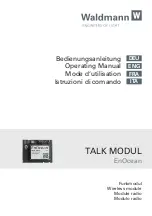
20NM50-00 E2
2016-05-17
Page 2
NM50 Mobile Gateway & WLAN Access Point
NM50 Mobile Gateway & WLAN Access Point
Maintenance Free and Extremely Rugged
The NM50 is a fanless and maintenance-free wireless access point, specifically designed
for use in railway cars and automotive applications operating in rugged environmental
conditions.
High Speed Internet and OpenWrt Firmware
The NM50 Access Point can support up to two WLAN modules, and provides reliable high
speed internet and local data connection to multiple WLAN compatible devices. A
configurable firewall protects WLAN clients and supports secure and uninterrupted
internet data access. The full-featured and modifiable firmware OpenWrt, allows easy
configuration of features.
High Performance Processor
The NM50 Access Point is based on QorIQ Power PC CPU technology from NXP. The
system is designed for fanless operation in temperatures ranging from -40 to +70°C
(+85°C for up to 10 minutes). Its special aluminum housing with cooling fins serves as a
heatsink for the internal electronics, and in this way provides conduction cooling. As a
member of the MEN family of extremely rugged industrial box PCs, the NM50 provides
the same flexibility and scalability, as well as a look and feel which is common to the
family.
Extended Coverage and Service Availability
A redundant upstream connection to a local server, or downstream to other access
points, to extend coverage and increase availability of service, is achieved via the two
Gigabit Ethernet ports available on 8-pin M12 connectors.
Compliant to Railway and Automotive Standards
The voltage supply for the fully configured NM50 Access Point is designed for maximum
flexibility and supports wide range input supply voltages from 14.4 to 154 VDC, and
meets all EN 50155 requirements for voltages ranging from 24 to 110 VDC. It is also fully
compliant to ISO 7637-2 (E-mark for automotive) standard.
Adaptable to Specific Application Needs
The NM50 comes in two standard versions and can be adapted to meet specification
application needs. Some of the most important configuration options include the
number of WLAN radios and type of upstream link.



































